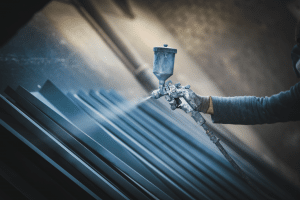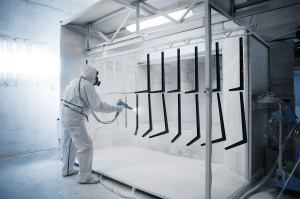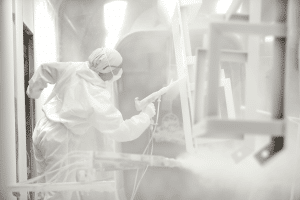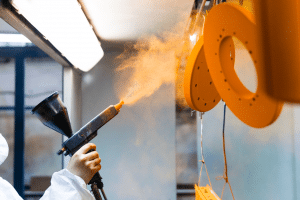
Table of Contents
Introduction
During the last few decades, powder coating has become somewhat of an industry standard. Especially for materials like metal, powder coating is now the optimal surface finish process for a wide variety of items, ranging from home appliances to industrial and automotive parts. Although powder coating has mostly been used for metal, it can also cover other materials, notably plastic, carbon fiber, and MDF (medium-density fiberboard).
Powder coating applies a fine coating of dry free-flowing powder to the surface. The process involves applying an electrostatic charge, which forces the powder particles into the microscopic pores and cracks in the material. The powder is then fused with heat and pressure, forming an even coat on top of the base material.
Compared with other coating processes, powder coating is much cleaner. It produces no volatile organic compounds, thereby significantly decreasing the cost of pollution control. Another advantage is that powder coating produces a much thicker and firmer coat, compared to paint.
Step By Step Process

This usually begins with the preparation stage. The substrate’s surface is cleaned, and its impurities are removed through different methods. Depending on the substrate’s material, different methods can be applied. For heat-sensitive materials like plastic, the recent breakthroughs in plasma pretreatment have enabled this technique to be widely adopted.
The application stage consists of the actual coating. This process usually requires an electrostatic spray gun. As the powder is sprayed towards the substrate, the electrostatic charge accelerates it towards the workpiece.
The final step is the curing or heating stage. Exposure to heat melts the powder into a uniform layer, which is then cooled to form a hard coating layer. Some solid materials like iron are usually preheated before coating, which helps avoid some coating inconsistencies later in the process. Curing usually takes inside a curing oven; a specialized piece of equipment capable of reaching very high temperatures. Depending on the substrate’s thickness and shape, the curing temperature can range between 325 to 450 Fahrenheit (162 to 232 C), for a curing time between 10 minutes to an hour.
Different Methods

There are several ways to classify powder coating methods and techniques. The most common way however is distinguishing between the different curing methods. There are three varieties of powder coating. Thermoset, thermoplastic, and UV curable powder coating. Thermoset relies on high temperature to melt the coating powder. After cooling, this layer forms into a higher molecular weight polymer. This process is also referred to as crosslinking, as it results in a network-like structure of the polymer. A crosslinker is usually added to the powder in this method; epoxy or polyester resins, or a hybrid. This relies on a temperature of approximately 160 C (320 F), which is why it is known as a low bake approach.
Thermoplastic is a slightly different process, as it doesn’t rely on any chemical reactions during drying. The coating is rather embedded into the substrate’s surface. This method usually involves specific types of coatings. Thermoplastic powder coatings melt at very high temperatures, are malleable and resistant.
UV curable powder coatings are more akin to thermoset, as it achieves cross-linking, but through a different mechanism. This method relies on a chemical photoinitiator contained in the coating powders, which responds to UV light energy. Also, UV curated powders melt in no more than 120 seconds when exposed to 110 to 130 C. The melted powders are then cured instantly using UV light.
Metallic Coatings

Metallic coatings can also constitute a distinct method, as they serve mainly a protective purpose. This method changes some properties of the surface, by laying a coating composed of metallic materials, usually a zinc alloy or aluminum. There are several common methods to this process. Usually, metal or iron are coated with zinc, by passing the material through molten zinc at a temperature of 460 C (860 F). This is known as hot-dip galvanizing.
Another method consists of coating the substrate’s surface with finely divided, semi-molten metallic material. This method, referred to as thermal spraying, is not very different from a regular powder coating process but differs in terms of the coating material.
Sheradizing is another form of metallic coating. This method consists of heating the substrate in an airtight container with zinc powder. As a thermal diffusion process occurs, the zinc-iron alloy forms a protective layer, embedded into the substrate’s surface.
Common Applications
Powder coating is a very common method for most manufacturing operations in different industries. The strength of the outer coating it provides, and resistance to corrosion, coupled with cost-effectiveness and ease make it one of the most reliable surface finish processes.
Several automotive components rely on powder coating. This process applies to anything from door handles and bumpers to brake components and battery trays , as well as medical equipment. This is largely due to the anti-corrosion properties of this method. Powder coating applies to some electrical components as well, notably connectors, lighting fixtures, and electrical junction boxes. Nowadays, many types of equipment, machine, and appliances go through this process, it has become the standard in other industries.
Some forms of metallic coatings serve only as a protective layer for the substrate, countering corrosion, chemical wear, and withstanding harsh environments. This is most commonly applied to steel.
Different Coating Materials

Each powder coating method aims at attaining specific qualities and results and relies on specific types of coating materials. The latter can affect the final result. For thermoplastic applications, most coatings can produce a durable and solid coating, capable of multiple formations and optimal for outdoor applications. The most common ones are PVC coatings.
Polyester powder coatings are also quite common, mostly in automobile parts that are exposed. They come in a variety of pigments. Nylon and polyolefin powder are also relied upon. They have high resistance to chemical wear and solvents, and offer smoother adhesion to the substrate.
Although thermoset coating also forms into a solid layer, they go through physical changes because of the cross-linking reactions during the curing process. Some thermoset coating can often become brittle after curing, especially when exposed to UV lights. This is why thermoset applications are usually reserved for indoor use. Epoxy is one of the most commonly used thermoset coatings. Epoxy-polyester coatings are also common, as they have better resistance. For high gloss finishes, acrylic coatings are optimal. These are most commonly used for exposed automobile engine parts.
UV cured coatings are different as they are most commonly used for heat-sensitive materials. Because the baking process is much shorter, it allows for the substrate to be coated but uses coating materials that are very sensitive to UV lights.
Pros & Cons
Powder coating is a very durable process, and the results it produces are often beneficial and cost-effective for commercial purposes. Its most prominent advantage is that it can achieve a variety of finishes, and protect against scratches and corrosion. It can also maintain the original color for a longer period. It’s also easier to produce thicker layers of coatings with this method, which is challenging using paint.
The uniformity and consistency of the coating are other characteristics of powder coating. This method can indeed obtain a consistent color finish across the substrate’s surface.
As much as it is efficient, powder coating has its limitations. This process does not cover large surfaces, and it becomes challenging to apply thin layers of coating. Although it has long been difficult to apply this method to heat-sensitive materials like plastic, it is now possible for more solid forms of plastic, with developments in UV curing.
Powder coating can also be used for other purposes. For example, aluminum coating serves as an excellent form of corrosion resistance, and also other chemical wear. Other forms of metallic coating are also used to strengthen an item.
General Guidelines
Aiming the spray gun directly at the frames can often result in a thicker layer of coating around the edge. This is sometimes known as a frame. It can be avoided by carefully manipulating the spray dispersal around the substrate’s surface
Excess fluidization in the hopper can often create air bubbles in the powder mixture. This would result in air bubbles and an inconsistent coating layer. This can also occur if there’s a build-up of powder in the spray gun.
To ensure the best result and required coating layer, choosing the right powder coating material is of the utmost importance. Usually, it is the desired effect that determines the choices of method and coating material.
Conclusion
As of now, powder coating is a standard process in most manufacturing operations. This technique has enabled several industries not only to improve the quality standards and durability of their products but also to reduce costs. The ongoing developments in industry and technology will only expand the potential of this technique.
